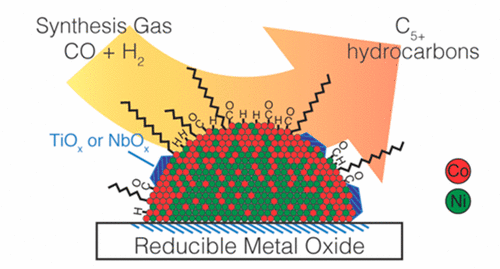当前位置:
X-MOL 学术
›
ACS Catal.
›
论文详情
Our official English website, www.x-mol.net, welcomes your
feedback! (Note: you will need to create a separate account there.)
Cobalt-Nickel Nanoparticles Supported on Reducible Oxides as Fischer-Tropsch Catalysts.
ACS Catalysis ( IF 11.3 ) Pub Date : 2020-06-09 , DOI: 10.1021/acscatal.0c00777 Carlos Hernández Mejía 1 , Jessi E S van der Hoeven 1, 2 , Petra E de Jongh 1 , Krijn P de Jong 1
ACS Catalysis ( IF 11.3 ) Pub Date : 2020-06-09 , DOI: 10.1021/acscatal.0c00777 Carlos Hernández Mejía 1 , Jessi E S van der Hoeven 1, 2 , Petra E de Jongh 1 , Krijn P de Jong 1
Affiliation

|
Efficient and more sustainable production of transportation fuels is key to fulfill the ever-increasing global demand. In order to achieve this, progress in the development of highly active and selective catalysts is fundamental. The combination of bimetallic nanoparticles and reactive support materials offers unique and complex interactions that can be exploited for improved catalyst performance. Here, we report on cobalt–nickel nanoparticles on reducible metal oxides as support material for enhanced performance in the Fischer–Tropsch synthesis. For this, different cobalt to nickel ratios (Ni/(Ni + Co): 0.0, 0.25, 0.50, 0.75, or 1.0 atom/atom) supported on reducible (TiO2 and Nb2O5) or nonreducible (α-Al2O3) oxides were studied. At 1 bar, Co–Ni nanoparticles supported on TiO2 and Nb2O5 showed stable catalytic performance, high activities and remarkably high selectivities for long-chain hydrocarbons (C5+, ∼80 wt %). In contrast, catalysts supported on α-Al2O3 independently of the metal composition showed lower activities, high methane production, and considerable deactivation throughout the experiment. At 20 bar, the combination of cobalt and nickel supported on reducible oxides allowed for 25–50% cobalt substitution by nickel with increased Fischer–Tropsch activity and without sacrificing much C5+ selectivity. STEM-EDX and IR of adsorbed CO pointed to a cobalt enrichment of the nanoparticle’s surface and a weaker adsorption of CO in Co–Ni supported on TiO2 and Nb2O5 and not on α-Al2O3, modifying the rate-determining step and the catalytic performance. Overall, we show the strong effect and potential of reducible metal oxides as support materials for bimetallic nanoparticles for enhanced catalytic performance.
中文翻译:

负载在可还原氧化物上的钴镍纳米粒子作为费-托催化剂。
高效,可持续发展的运输燃料生产是满足不断增长的全球需求的关键。为了实现这一点,在开发高活性和选择性催化剂方面的进展是至关重要的。双金属纳米颗粒和反应性载体材料的结合提供了独特而复杂的相互作用,可以利用这些相互作用来改善催化剂的性能。在这里,我们报道了可还原金属氧化物上的钴镍纳米粒子作为支持材料,以提高费-托合成的性能。对于这一点,不同的钴对镍比(镍/(镍+钴):0.0,0.25,0.50,0.75,或1.0原子/原子)支撑在还原(的TiO 2和Nb 2 ö 5)或不可还原的(α-Al系2 Ø 3)的氧化物进行了研究。在1 bar下,负载在TiO 2和Nb 2 O 5上的Co-Ni纳米颗粒表现出稳定的催化性能,高活性和对长链碳氢化合物(C 5+,〜80 wt%)的高选择性。与此相反,催化剂负载在的α-Al 2 ö 3独立地在金属组合物显示出较低的活性,高的甲烷生产,并在整个实验中相当大的失活。在20 bar的压力下,钴和镍的组合负载在可还原的氧化物上,从而使镍可替代25–50%的钴,从而提高了Fischer-Tropsch活性,并且不会降低C 5+选择性。STEM-EDX和吸附的CO指出至纳米粒子表面的钴的富集的IR和在钴-镍较弱吸附CO的支撑在TiO 2和Nb 2 ö 5,而不是在的α-Al 2 ö 3,修改所述速率-确定步骤和催化性能。总的来说,我们显示出可还原金属氧化物作为双金属纳米颗粒的载体材料的强大作用和潜力,以增强催化性能。
更新日期:2020-07-02
中文翻译:

负载在可还原氧化物上的钴镍纳米粒子作为费-托催化剂。
高效,可持续发展的运输燃料生产是满足不断增长的全球需求的关键。为了实现这一点,在开发高活性和选择性催化剂方面的进展是至关重要的。双金属纳米颗粒和反应性载体材料的结合提供了独特而复杂的相互作用,可以利用这些相互作用来改善催化剂的性能。在这里,我们报道了可还原金属氧化物上的钴镍纳米粒子作为支持材料,以提高费-托合成的性能。对于这一点,不同的钴对镍比(镍/(镍+钴):0.0,0.25,0.50,0.75,或1.0原子/原子)支撑在还原(的TiO 2和Nb 2 ö 5)或不可还原的(α-Al系2 Ø 3)的氧化物进行了研究。在1 bar下,负载在TiO 2和Nb 2 O 5上的Co-Ni纳米颗粒表现出稳定的催化性能,高活性和对长链碳氢化合物(C 5+,〜80 wt%)的高选择性。与此相反,催化剂负载在的α-Al 2 ö 3独立地在金属组合物显示出较低的活性,高的甲烷生产,并在整个实验中相当大的失活。在20 bar的压力下,钴和镍的组合负载在可还原的氧化物上,从而使镍可替代25–50%的钴,从而提高了Fischer-Tropsch活性,并且不会降低C 5+选择性。STEM-EDX和吸附的CO指出至纳米粒子表面的钴的富集的IR和在钴-镍较弱吸附CO的支撑在TiO 2和Nb 2 ö 5,而不是在的α-Al 2 ö 3,修改所述速率-确定步骤和催化性能。总的来说,我们显示出可还原金属氧化物作为双金属纳米颗粒的载体材料的强大作用和潜力,以增强催化性能。











































 京公网安备 11010802027423号
京公网安备 11010802027423号